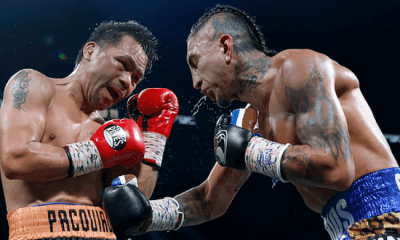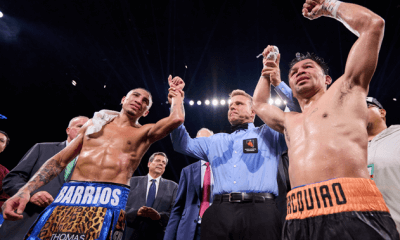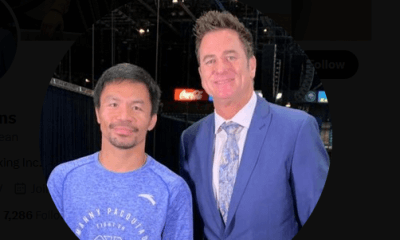Featured Articles
Born on October 8th, 1917…. Billy Conn, The Pittsburgh Kid
Former Light Heavyweight World Champion Billy Conn was born on October 8th, 1917 in East Liberty, Pennsylvania.
In his youth, Billy Conn met a Pittsburgh boxer named Johnny Ray, a celebrated Lightweight from the Pittsburgh area that had fought professionally from 1913 to 1924. Ray had also been a sparring partner for the legendary Harry Greb, and it was Ray who would guide Conn’s career as his manager in the professional ranks. Author Paul Kennedy described Ray, whose real name is Howard Pitler, as a father figure for Conn, and they would stay together throughout Conn’s professional career.
Conn would not have an amateur career, jumping directly into the pro ranks, Conn fought his first fights in Western Pennsylvania and West Virginia, in the area around Pittsburgh, which was seen as a boxing hotbed. Conn cut his teeth in the early going, as he posted a known record of 8-6 in his early career, learning the craft of boxing in the ring. There are conflicting reports as to Conn’s actual debut though it came in June or July of 1934, when Conn was sixteen.
After the rocky start, Conn would have his fight game along enough to peel off 27 wins in a row, many against men with a great deal more experience than he had. In December of 1936, he faced Fritzie Zivic, another young fighter from Pittsburgh who would go on to a hall of fame career, and win. He would follow that win by defeating veterans Babe Risko (63-17-10 record at the time) and Vince Dundee (117-17-14 at the time). He would follow that with wins over Young Corbett III and Teddy Yarosz later in 1937, so Conn had firmly established himself as an up and comer by the time he was 20 years old.
By the start 1939, Conn had made enough noise in boxing circles to get a match as the main event at Madison Square Garden, the mecca of boxing. On January 6th, Conn faced then Middleweight Champion Fred Apostoli, in a match the AP described “as wild-and-wooly a 10 round punch party as MSG’s fistic arena has seen in years”. Conn got the nod with the judges. On February 10th, Conn was asked to do it again, and he would, defeating Apostoli a second time, this one over 15 rounds.
Conn would go on to headline MSG five times that year. In a July 13th match against Melio Bettina, Conn won the Light Heavyweight Championship of the world. He defended the belt in a re-match and then retained it by winning a pair of fights against the dangerous Gus Lesnevich.
Bob Pastor, Al McCoy, Lee Savold, Buddy Knox. Conn was facing and defeating many of the top names in several weight classes. In 1941, he vacated the Light Heavyweight title to compete at Heavyweight, and on June 18th, 1941, he challenged Heavyweight Champion Joe Louis at the Polo Grounds in New York City.
Louis, a legendary champion who was at the peak of his title reign in the early 1940’s, would later describe the first Billy Conn match as his toughest bout. For 13 rounds, Conn out-boxed Louis. Despite giving up nearly 30 lbs in the fight, Conn was able to stagger Louis in the 12th round. In the 13th, Conn came out looking for the kill, but it was Louis who closed out the fight with two right hands. Conn was KO’d while ahead on two of the three judges cards, but he had fought what would be his most memorable fight.
Conn kept right on fighting, and after defeating Tony Zale over 12 rounds at MSG in February of 1942, Conn would join the United States war effort, and he would be away from boxing for four years. Upon his return, he was still a popular draw, and he had the attention of the country’s boxing fans, but the 4 years away from the ring affected his sharpness. In those 4 years away,Billy Conn had lost a little something of his magic.
On June 19th, 1946 Billy Conn would return to boxing for a return fight with Joe Louis that would air on the National Broadcast Network (NBC). After 4 years away from competing, Conn fell short, getting KO’d in the 8th round in New York’s Yankee Stadium in front of over 45,000 spectators. Conn fought just twice more after that, winning both bouts, before retiring for good.
Conn retired with a known record of 64 wins, 11 losses and 1 draw. Conn’s record is defined by the quality of his competition, as he fought many of the most experienced and decorated fighters of his era and came out on top. He was recognized as the Light heavyweight Champion of the World from 1939 to 1941, and he has been inducted into every version of boxing hall of fame out there, including going into the Canastota, New York International Boxing Hall of Fame in 1990, with the inaugural class.
Throughout his career, Conn was always known as a ‘baby-face’, and he is reported to have turned down several offers to head to Hollywood and make films, both during his career and after, but Conn turned down the chances. In 1941, at the peak of his boxing career, he did star in a film called ‘The Pittsburgh Kid’ where he played himself. Legendary World Champion Henry Armstrong and hall of fame referee Arthur Donovan made cameo appearances.
Sometime in his retirement, Conn moved his family to Las Vegas where he was working with the casinos, but he moved back to the Squirrel Hill neighborhood near Pittsburgh. where he lived the rest of his life with his wife Mary Louise. Billy Conn, ‘The Pittsburgh Kid’ passed away in Pittsburgh on May 29th, 1993 at the age of 75. As of 2007, Mary Louise was still living in Squirrel Hill.
Billy Conn would have been 98 years old today. Happy Birthday, Billy.
-

 Featured Articles2 weeks ago
Featured Articles2 weeks agoResults and Recaps from New York Where Taylor Edged Serrano Once Again
-

 Featured Articles2 weeks ago
Featured Articles2 weeks agoResults and Recaps from NYC where Hamzah Sheeraz was Spectacular
-

 Featured Articles3 weeks ago
Featured Articles3 weeks agoFrom a Sympathetic Figure to a Pariah: The Travails of Julio Cesar Chavez Jr
-

 Featured Articles2 weeks ago
Featured Articles2 weeks agoPhiladelphia Welterweight Gil Turner, a Phenom, Now Rests in an Unmarked Grave
-

 Featured Articles7 days ago
Featured Articles7 days agoManny Pacquiao and Mario Barrios Fight to a Draw; Fundora stops Tim Tszyu
-

 Featured Articles3 weeks ago
Featured Articles3 weeks agoCatterall vs Eubank Ends Prematurely; Catterall Wins a Technical Decision
-

 Featured Articles5 days ago
Featured Articles5 days agoArne’s Almanac: Pacquiao-Barrios Redux
-

 Featured Articles2 weeks ago
Featured Articles2 weeks agoFrom the Boondocks to the Big Time, The Wild Saga of Manny Pacquiao’s Sidekick Sean Gibbons












